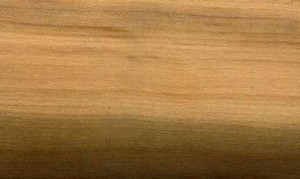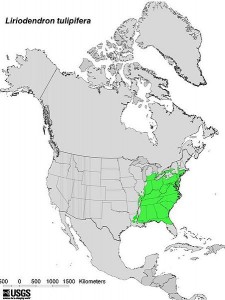The picture at left shows just some of the wide ranges of color found in Poplar lumber, via The Wood Explorer database.
Common trade names: Poplar, Yellow poplar.
Genus: Liriodendron tulipifera
Janka Hardness (pounds-force): 540
Description: Poplar is a deciduous with lumber that is pale, with grey and green coloring streaked in. It’s very soft for a so-called hardwood, and its grain is generally straight and consistent, with a medium texture. Pores are sealed, making this a great selection for paint, and to a degree, stain. Personal preferences here, I suppose, but the greys and greens have always made me lean toward using Poplar as a paint-grade performance species only. But it will certainly take stain.
Location: Eastern United States. Range in picture of Liriodendron tulipifera via Wikipedia via USGS.
Common Aliases: Yellow poplar, American tulipwood, Blue poplar, Canadian whitewood, Saddletree, Tulip poplar, Virginian poplar, White poplar, Yellow-wood.
Performance: Poplar is very easy to work, and it takes paint exceptionally well. It also stains nicely, if that’s the look you’re going for. For whatever reason, I have memories of Poplar being much more widely available in local marketplaces better than a decade ago. Everytime I worked the wood, I was highly satisfied, because it was a piece of cake. The wood held together nicely, and I was able to crank out volume in a big hurry with this species. If I were to use paint grade trim anywhere in my place, it would be out of poplar. If I can get it in Ottawa or Pomona.
Common Uses: Millwork, paint-grade trim, stain-grade trim, shelving, cabinetry, just about anything for interior use that is to be painted, I would highly recommend poplar. I could name thousands of common uses for this species. A great wood, in my opinion, and very underrated.
From: The Wood Database
Common Name(s): Poplar, Tulip Poplar, Yellow Poplar
Scientific Name: Liriodendron tulipifera
Distribution: Eastern United States
Tree Size: 130-160 ft (40-50 m) tall, 6-8 ft (1.8-2.5 m) trunk diameter
Average Dried Weight: 32 lbs/ft3 (515 kg/m3)
Basic Specific Gravity: .40
Hardness: 540 lbf (2,400 N)
Rupture Strength: 10,100 lbf/in2 (69,660 kPa)
Elastic Strength: 1,580,000 lbf/in2 (10,900 MPa)
Crushing Strength: 5,540 lbf/in2 (38.2 MPa)
Shrinkage: Radial: 4.6%, Tangential: 8.2%, Volumetric: 12.7%, T/R Ratio: 1.8

